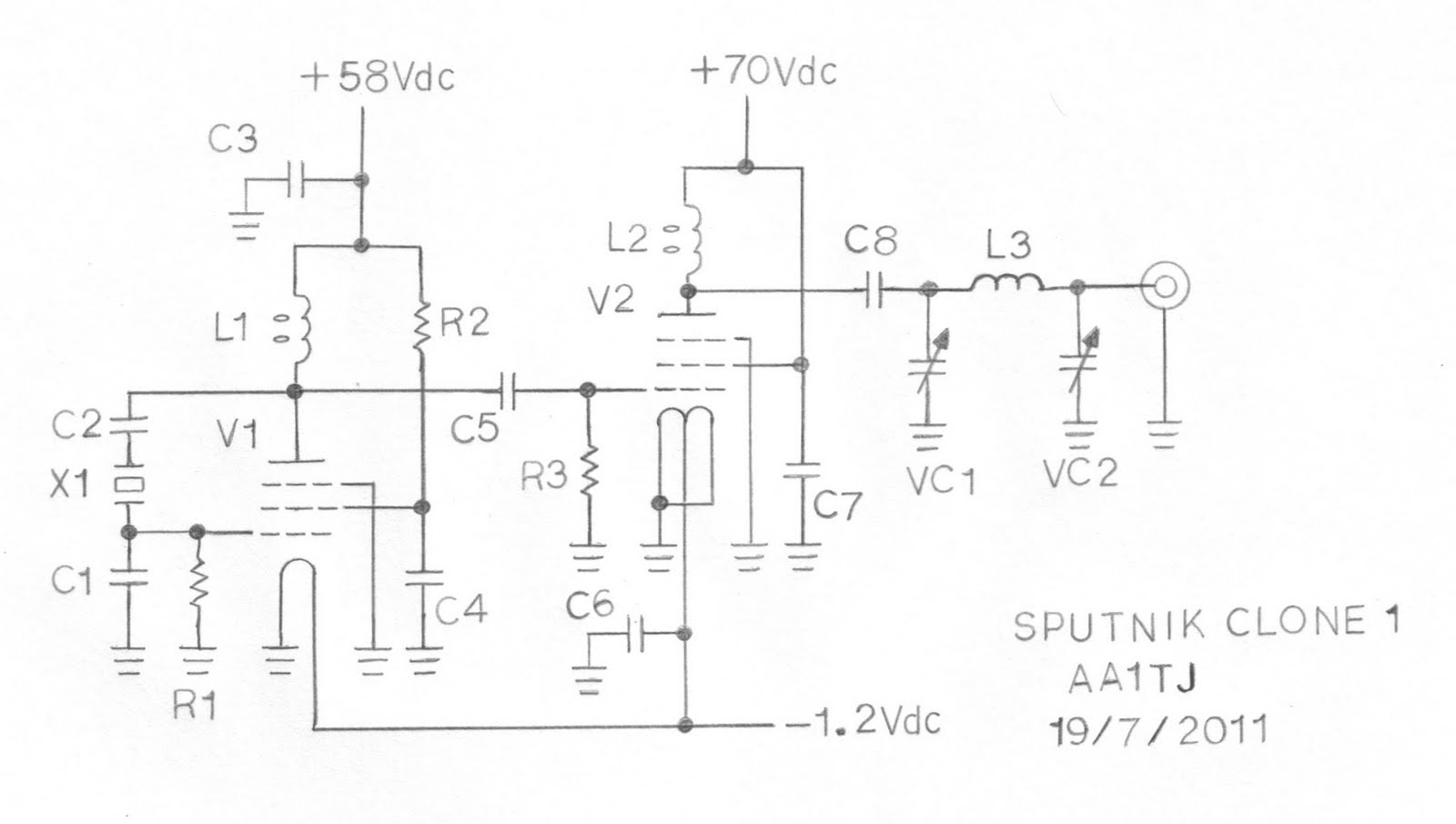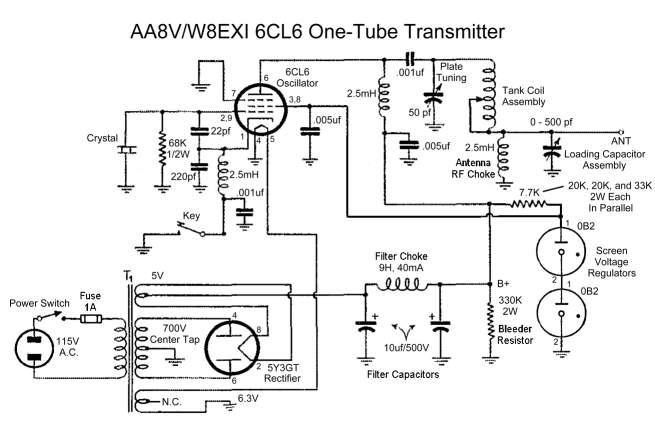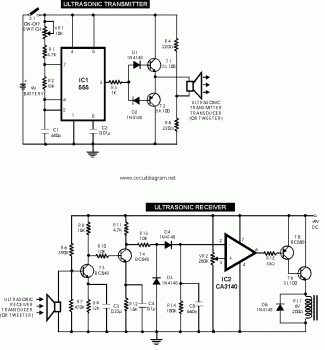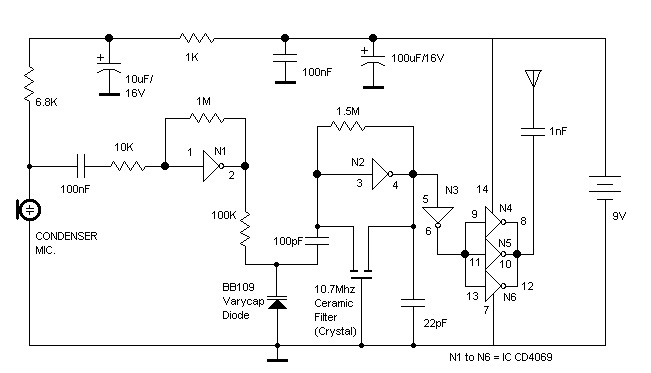
Sputnik QSO Party Transmitter Prototype

This document describes a prototype transmitter for the Sputnik QSO Party. The RF output power is 450 mW, with 70 V DC at 14.4 mA on the V2 anode. The screen current (G2) for V2 is 1.6 mA, while the anode current for V1 is 1.05 mA with 45 V DC at 176 µA on the screen (G2). These vacuum tubes are capable of performing well; however, for long-term operation, it is essential to adhere to the maximum electrode ratings as specified in the datasheets. The simple MOPA (Master-Oscillator -> Power-Amplifier) vacuum-tube radio transmitter circuit described was commonly used in the mid-1950s. A crystal-controlled Pierce oscillator drives a Class-C power amplifier (PA). The grid bias for the PA is derived from rectified PA grid current, which means that the PA stage must not be operated without the oscillator drive signal present. The circuit does not include the CW keying and transmit/receive switching circuitry. The original Sputnik-1 signal can be heard in a recording, where the oscillator signal bleed-through during "key-up" intervals is noticeable, indicating that the oscillator stage was continuously running while only the PA stage was keyed on and off. The plan is to key the PA stage (through the anode supply or possibly using grid-block keying), while the oscillator will be turned off only during receiving. A low-pass filter may be necessary between the Pi-network impedance matching circuit and the antenna. The RF output spectrum has not been checked, but the inherent Pi-network 2nd harmonic attenuation is approximately 28 dB. The value of capacitor C1 may need to be adjusted based on the specific circuit layout, as it is crucial for maintaining the optimal level of oscillator feedback and providing the correct loading capacitance for the quartz crystal resonator. The original keying plan for Sputnik 1 involved alternating between the 40.002 MHz and 20.005 MHz transmitters every 0.3 seconds, which helped stabilize the battery load.
The transmitter prototype employs a Master-Oscillator Power-Amplifier (MOPA) configuration, utilizing vacuum tubes to generate RF signals. The Pierce oscillator, which is crystal-controlled, is responsible for producing the fundamental frequency, while the Class-C power amplifier is tasked with amplifying the RF signal for transmission. The design ensures that the PA stage operates only when driven by the oscillator, preventing potential damage or inefficiency that could arise from operating the PA without an input signal.
The circuit's performance is influenced by the careful selection and adjustment of components, particularly the feedback capacitor (C1), which is critical for ensuring stable oscillator operation and optimal loading for the crystal. The Pi-network serves as an impedance matching circuit, enhancing the efficiency of the power transfer to the antenna, while the low-pass filter is intended to suppress unwanted harmonic frequencies that may be generated during transmission.
The original keying strategy employed by Sputnik 1, which alternated between two frequencies, is an effective method for managing battery life and ensuring consistent operation. This approach allows for the transmitter to maintain a steady load on the power supply, which is particularly important in battery-operated devices. The proposed modifications, including the implementation of grid-block keying and the potential use of a low-pass filter, are essential considerations for improving the overall performance and reliability of the transmitter prototype.Here is my Sputnik QSO Party transmitter prototype. The RF output power is 450mW with 70Vdc @ 14. 4mA on the V2 anode. The V2 screen (G2) current is 1. 6mA. The V1 anode current is 1. 05mA with 45Vdc @ 176uA at the screen (G2). These little vacuum tubes arecapable performers, however, for long-life operation it`s important toheed the maximum electrod eratings as shown on the datasheets (links given below). The simple MOPA (Master-Oscillator -> Power-Amplifier) vacuum-tube radio transmitter circuit shown below was well-known in the mid-1950`s. A crystal-controlled Pierce oscillator drives a Class-C PA. The PA grid bias is derived from rectified PA grid current (thus; never run the PA stage without the oscillator drive signal present!).
The CW keying and transmit/receive switching circuitry are not shown in the circuit below. Please click here to listen to a strong-signal recording of the original Sputnik-1. The oscillator signal bleed-though during "key-up" intervals is clearly audible. This implies that the oscillator stage was allowed to run continuously. Presumably, only the power amplifier (PA) stage was keyed on/off. As such, I plan to only key my PA stage (via the anode supply or perhaps using grid-block keying). My oscillator will be switched off only while I`m receiving signals. A low-pass filter may be required between the Pi-network impedance matching circuit and the antenna. I have not yet checked the RF output spectrum, however the inherent Pi-network 2nd harmonic attenuation is only ~28dB. The value of C1 may have to be adjusted for your particular circuit layout. This capacitor helps both to maintain the optimum level of oscillator feedback and provide the proper loading capacitance for the quartz crystal resonator.
The drawing below shows the original Sputnik 1 keying plan for normal conditions; 0. 3 seconds on, 0. 3 seconds off. While the 40. 002MHz transmitter was off the 20. 005MHz transmitter was on, and vice versa. This helped to hold the battery load steady. 🔗 External reference
The transmitter prototype employs a Master-Oscillator Power-Amplifier (MOPA) configuration, utilizing vacuum tubes to generate RF signals. The Pierce oscillator, which is crystal-controlled, is responsible for producing the fundamental frequency, while the Class-C power amplifier is tasked with amplifying the RF signal for transmission. The design ensures that the PA stage operates only when driven by the oscillator, preventing potential damage or inefficiency that could arise from operating the PA without an input signal.
The circuit's performance is influenced by the careful selection and adjustment of components, particularly the feedback capacitor (C1), which is critical for ensuring stable oscillator operation and optimal loading for the crystal. The Pi-network serves as an impedance matching circuit, enhancing the efficiency of the power transfer to the antenna, while the low-pass filter is intended to suppress unwanted harmonic frequencies that may be generated during transmission.
The original keying strategy employed by Sputnik 1, which alternated between two frequencies, is an effective method for managing battery life and ensuring consistent operation. This approach allows for the transmitter to maintain a steady load on the power supply, which is particularly important in battery-operated devices. The proposed modifications, including the implementation of grid-block keying and the potential use of a low-pass filter, are essential considerations for improving the overall performance and reliability of the transmitter prototype.Here is my Sputnik QSO Party transmitter prototype. The RF output power is 450mW with 70Vdc @ 14. 4mA on the V2 anode. The V2 screen (G2) current is 1. 6mA. The V1 anode current is 1. 05mA with 45Vdc @ 176uA at the screen (G2). These little vacuum tubes arecapable performers, however, for long-life operation it`s important toheed the maximum electrod eratings as shown on the datasheets (links given below). The simple MOPA (Master-Oscillator -> Power-Amplifier) vacuum-tube radio transmitter circuit shown below was well-known in the mid-1950`s. A crystal-controlled Pierce oscillator drives a Class-C PA. The PA grid bias is derived from rectified PA grid current (thus; never run the PA stage without the oscillator drive signal present!).
The CW keying and transmit/receive switching circuitry are not shown in the circuit below. Please click here to listen to a strong-signal recording of the original Sputnik-1. The oscillator signal bleed-though during "key-up" intervals is clearly audible. This implies that the oscillator stage was allowed to run continuously. Presumably, only the power amplifier (PA) stage was keyed on/off. As such, I plan to only key my PA stage (via the anode supply or perhaps using grid-block keying). My oscillator will be switched off only while I`m receiving signals. A low-pass filter may be required between the Pi-network impedance matching circuit and the antenna. I have not yet checked the RF output spectrum, however the inherent Pi-network 2nd harmonic attenuation is only ~28dB. The value of C1 may have to be adjusted for your particular circuit layout. This capacitor helps both to maintain the optimum level of oscillator feedback and provide the proper loading capacitance for the quartz crystal resonator.
The drawing below shows the original Sputnik 1 keying plan for normal conditions; 0. 3 seconds on, 0. 3 seconds off. While the 40. 002MHz transmitter was off the 20. 005MHz transmitter was on, and vice versa. This helped to hold the battery load steady. 🔗 External reference





